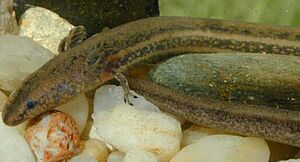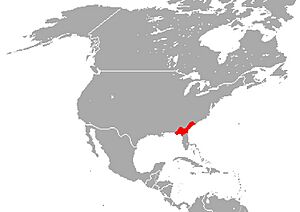Northern dwarf siren facts for kids
Quick facts for kids Northern dwarf siren |
|
|---|---|
 |
|
| Conservation status | |
| Scientific classification | |
| Genus: |
Pseudobranchus
|
| Species: |
striatus
|
 |
|
| Synonyms | |
|
Siren striata LeConte, 1824 |
|
The northern dwarf siren (Pseudobranchus striatus) is a special kind of salamander that lives in water its whole life. It's unique because it doesn't have back legs! You can find this small creature in the Southeastern United States. It's one of only two types of dwarf sirens known.
There are three different kinds, or subspecies, of the northern dwarf siren:
- P. s. striatus, called the broad-striped dwarf siren.
- P. s. lustricolus, known as the Gulf Hammock dwarf siren.
- P. s. spheniscus, which is the slender dwarf siren.
Contents
What Does the Northern Dwarf Siren Look Like?
The northern dwarf siren is the smallest siren known. It usually grows to be about 4 to 9.9 inches (10 to 25 cm) long. Like other sirens, it lives in water all the time and keeps its gills throughout its life.
This siren looks thin and a bit like an eel. You can spot it by the light stripes on its sides. Its back is usually brown or light gray. It has only one gill opening and a tail that looks like a fin. It also has special grooves on its sides and three toes on each of its two front feet.
These sirens are very shy. They often hide among the roots of water plants like water hyacinth or in the mud at the bottom of ponds. They eat tiny creatures without backbones, called invertebrates. If a pond dries up, they can bury themselves in the mud to stay safe until the water returns. If you pick one up, it might make a soft yelping sound!
Northern Dwarf Siren Reproduction
Northern dwarf sirens lay their eggs in the spring. They gather in large groups in the pond or spring where they were born. It's hard to tell male and female sirens apart just by looking at them.
They lay their eggs one by one on the roots of water plants. The eggs are covered in a soft membrane. After about a month, tiny larvae hatch from the eggs. They are only about 0.6 inches (1.4 cm) long when they hatch. It takes them about four years to grow up and be able to have their own babies. A female siren can lay up to 61 eggs in one spring!
Where Do Northern Dwarf Sirens Live?
This siren prefers to live in shallow ditches, swampy areas with cypress trees, and ponds filled with weeds. You can find them on the coastal plains of South Carolina, Georgia, and Florida.
Types of Northern Dwarf Sirens
There are three different kinds of northern dwarf sirens:
Broad-Striped Northern Dwarf Siren
The broad-striped northern dwarf siren (P. s. striatus) is short and a bit chunky. It has a wide, dark-brown stripe down its back. There's also a thin, light stripe in the middle of its back, with wide yellow or light-brown stripes on either side. You can find this type from southern South Carolina all the way to northeast Florida.
Slender Northern Dwarf Siren
The slender northern dwarf siren (P. s. spheniscus) has a narrow head and a snout shaped like a wedge. It has two clear tan or yellow stripes on each side of its body. This type is found in a few different places in southwest Georgia and the Florida panhandle.
Gulf Hammock Northern Dwarf Siren
The Gulf Hammock northern dwarf siren (P. s. lustricolus) is large and strong, with a flat head and a blunt snout. It has three thin light stripes inside a wide dark stripe down its back. It also has two side stripes: the top one is orange-brown, and the bottom one is silvery-white. This subspecies hasn't been seen since 1951, when it was first described. It is only known from Levy and Citrus Counties in Florida.



